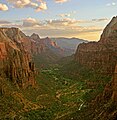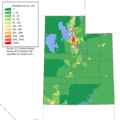Portal:Utah
The Utah Portal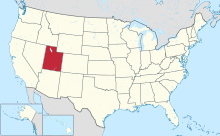  Utah is a state in the western United States. It is one of the Mountain States, sharing the Four Corners region with Arizona, Colorado, and New Mexico. It also borders Wyoming to the northeast, Idaho to the north, and Nevada to the west. In comparison to all the U.S. states and territories, Utah, with a population of just over three million, is the 13th largest by area, the 30th most populous, and the 11th least densely populated. Urban development is mostly concentrated in two regions: the Wasatch Front in the north-central part of the state, which includes the state capital, Salt Lake City, and is home to roughly two-thirds of the population; and Washington County in the southwest, which has approximately 180,000 residents. Most of the western half of Utah lies in the Great Basin. Utah has been inhabited for thousands of years by various indigenous groups, such as the ancient Puebloans, the Navajo, and the Ute. The first Europeans to arrive – in the mid-16th century – were the Spanish. Because of the region's challenging geography and harsh climate, it only became a peripheral part of New Spain (and later of Mexico). Even while it was Mexican territory, many of the Utah region's earliest European settlers were from the United States; notable among these were Mormons who were fleeing marginalization and persecution in the United States and arrived via the so-called Mormon Trail. In 1848, after the Mexican–American War, the region was annexed by the U.S., becoming part of the Utah Territory, which included what later became Colorado and Nevada. Disputes between the dominant Mormon community and the federal government delayed Utah's admission as a state: in 1896, after it agreed to outlaw polygamy, it was admitted as the 45th state. People from Utah are known as Utahns. Slightly over half of all Utahns are Mormons, the vast majority of whom are members of the Church of Jesus Christ of Latter-day Saints (LDS Church), which has its world headquarters in Salt Lake City; Utah is the only state where a majority of the population belongs to a single church. The LDS Church greatly influences Utahn culture, politics, and daily life, though since the 1990s the state has become more religiously diverse as well as secular. (Full article...) Entries here consist of Good and Featured articles, which meet a core set of high editorial standards.
The Jordan River is a 51.4-mile-long (82.7 km) river in the U.S. state of Utah. Regulated by pumps at its headwaters at Utah Lake, it flows northward through the Salt Lake Valley and empties into the Great Salt Lake. Four of Utah's six largest cities border the river: Salt Lake City, West Valley City, West Jordan, and Sandy. More than a million people live in the Jordan Subbasin, part of the Jordan River watershed that lies within Salt Lake and Utah counties. During the Pleistocene, the area was part of Lake Bonneville. Members of the Desert Archaic Culture were the earliest known inhabitants of the region; an archaeological site found along the river dates back 3,000 years. Mormon pioneers led by Brigham Young were the first European American settlers, arriving in July 1847 and establishing farms and settlements along the river and its tributaries. The growing population, needing water for drinking, irrigation, and industrial use in an arid climate, dug ditches and canals, built dams, and installed pumps to create a highly regulated river. (Full article...) Selected image - The cauldron used for the 2002 Winter Olympics in Salt Lake City, Utah was moved from the top of the Olympic stadium and now anchors the Salt Lake 2002 Olympic Cauldron Park just south of Rice-Eccles Stadium. The flame is lit on special occasions, such as the opening weekend of the 2006 Winter Olympics.
February selected anniversaries
Selected biography - Alfred William McCune (June 11, 1849 – March 28, 1927) was an American railroad builder, mine operator, and politician from the state of Utah. Owner of several retail and construction businesses, he helped build the Montana Central Railway and a portion of the Utah Southern Railroad, founded the Utah and Pacific Railroad, and built railways in Peru, among other projects. He also owned many profitable mines in Canada, Montana, Peru, and Utah, including the Payne Mine—which paid the most dividends in the history of British Columbia. Late in life, he co-founded the Cerro de Pasco Investment Company, which became the largest copper investor in South America and the largest American investor in Peru until it was nationalized in 1974. He was one of Utah's first millionaires. He nearly became a U.S. Senator in 1899, but after being unable to receive a majority after numerous ballots and accusations of bribery, the state legislature adjourned without electing anyone to the seat. The Senate seat remained vacant for two years, and in 1901 another man was elected to the position. (Full article...) Selected article -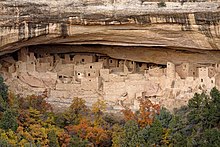 The Ancestral Puebloans, also known as the Basketmaker-Pueblo culture, were an ancient Native American culture that spanned the present-day Four Corners region of the United States, comprising southeastern Utah, northeastern Arizona, northwestern New Mexico, and southwestern Colorado. They are believed to have developed, at least in part, from the Oshara tradition, which developed from the Picosa culture. The people and their archaeological culture are often referred to as Anasazi, a term introduced by Alfred V. Kidder from the Navajo word anaasází meaning 'enemy ancestors' (anaa– 'enemy', -sází 'their ancestors') although Kidder thought it meant 'old people'. Contemporary Puebloans object to the use of this term, with some viewing it as derogatory. In another account the term "Anasazi", originated from a Navajo adoption of a Ute word that literally means "ancient enemy" or "primitive enemy", but was used by the Navajo to mean "savage" or "barbarian", hence the modern Pueabloan people's rejection of the term. The Ancestral Puebloans lived in a range of structures that included small family pit houses, larger structures to house clans, grand pueblos, and cliff-sited dwellings for defense. They had a complex network linking hundreds of communities and population centers across the Colorado Plateau. They held a distinct knowledge of celestial sciences that found form in their architecture. The kiva, a congregational space that was used mostly for ceremonies, was an integral part of the community structure. (Full article...) Did you know -
Selected panorama -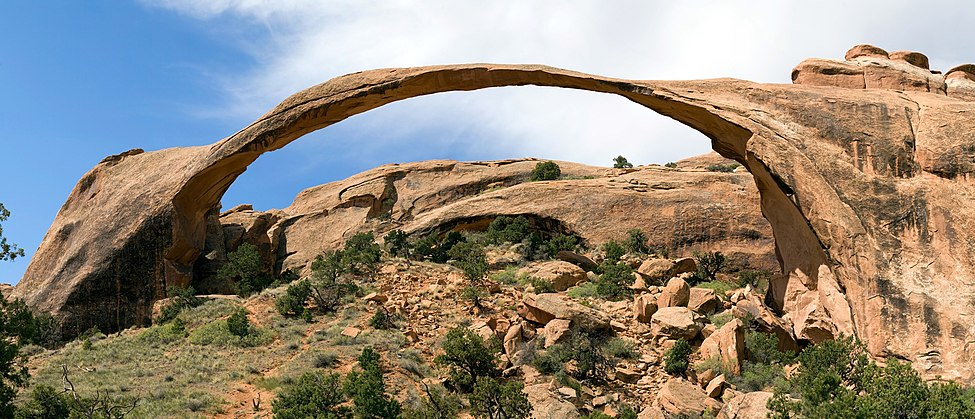 Landscape Arch in Arches National Park
TopicsCategoriesGeneral imagesThe following are images from various Utah-related articles on Wikipedia.
State facts
State symbols:
Featured contentArticles:
Lists:
Pictures: Related portals
Lists
Related WikiProjectsNew articlesThis list was generated from these rules. Questions and feedback are always welcome! The search is being run daily with the most recent ~14 days of results. Note: Some articles may not be relevant to this project.
Rules | Match log | Results page (for watching) | Last updated: 2025-02-16 22:51 (UTC) Note: The list display can now be customized by each user. See List display personalization for details.
Things you can doAssociated WikimediaThe following Wikimedia Foundation sister projects provide more on this subject:
Discover Wikipedia using portals |






















